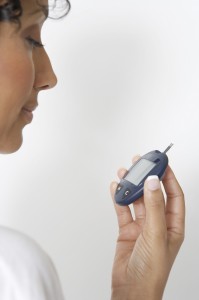What is hypoglycemia?
The word “hypo” means low; “glycemia” refers to “blood glucose” or “blood sugar” – so hypoglycemia is low blood glucose or low blood sugar.
Hypoglycemia is a blood glucose level of less than 70 mg/dL. Talk to your health care provider about your individual blood glucose targets to find out what level is too low for you.
It’s important to know that having diabetes does not cause hypoglycemia. However, some of the medications used to treat diabetes lower your blood glucose so they can cause hypoglycemia, especially if you miss or delay meal, if you are more active than usual, or you accidentally take too much medication. Ask your health care professional if your medication can cause hypoglycemia.
Symptoms of hypoglycemia
Hunger is often the first symptom of a decrease in your blood glucose, and it simply indicates that it’s time to eat. As your blood glucose levels decrease, symptoms of hypoglycemia can make it difficult to continue your current activity because you don’t feel well. Severe hypoglycemia can become very serious and must be recognized and treated.
The symptoms of hypoglycemia:
Hunger
Shaking or trembling
Sweating
Dizziness
Light-headedness
Sleepiness
Confusion
Irrational behavior
Difficulty speaking
Nervousness or anxiety
Irritability or anger
Weakness
Clumsiness
Fainting
The symptoms of severe hypoglycemia:
Seizures
Coma
Death
The symptoms of severe hypoglycemia during sleep:
Crying out Nightmares
Pajamas or sheets damp from perspiration
Feeling tired, irritable, or confused after waking up
The only sure way to know whether you are experiencing hypoglycemia is to check your blood sugar. If you have symptoms but you are unable to check your blood sugar for any reason, treat the hypoglycemia.
Wear a medical alert bracelet and sure that you, and the people you spend time with, understand how to treat hypoglycemia before it occurs.
How to treat hypoglycemia
- If you have symptoms of hypoglycemia, test your blood glucose if possible. If it’s impossible to test, then treat it anyway.
- If your blood glucose is less than 70 mg/dL or you can’t test, eat or drink something with 15 grams of carbohydrate. Here are some examples.
3-4 glucose tablets
15 grams of glucose gel
6 saltine crackers
1 cup of skim milk
7-8 hard roll candy (such as Life Savers)
1 snack size package of gummy fruit
4 ounces of juice (a small juice box)
4 ounces of cola (not diet)
1 tablespoon of sugar or honey
If you are unable to consume carbohydrate by mouth, 911 should be called immediately.
Always carry some form of carbohydrate with you (see list above), especially if a health care provider tells you that you are at risk for a low blood sugar reaction.
Retest and re-treat if needed. Wait fifteen minutes then retest. If your blood glucose is still below 70 mg/dL, re-treat with 15 grams of carbohydrates. These steps should be repeated until your blood glucose level is 70 mg/dL or above.
Resist the urge to keep eating since over-consuming carbohydrates will make your blood sugar rise higher, not faster. That can make it go above your target range.
If your next meal is an hour or more away, eat a small snack, preferably with 15-30 grams of carbohydrates, and some protein and fat such as half a sandwich, yogurt, half cup of trail mix, or peanut-butter and crackers.
- Keep a careful log of all your low blood glucose readings to look for patterns and identify possible causes and solutions. For example, does it happen at a particular time of day or after a certain type of activity? You can often trace the causes of low blood glucose back to changes in eating, physical activity, or medications.
If you can’t figure out why you have low blood glucose, call your healthcare provider. Your medications may need to be adjusted.
Follow up. If you have two or more low blood glucose readings in a week, call your health care provider. Based on your log, you might be asked to add snacks or adjust what, when, and how much medication you take.
You’ll find additional information about managing prediabetes and diabetes in Eat What You Love, Love What You Eat with Diabetes: A Mindful Eating Program for Thriving with Prediabetes or Diabetes.
Download a Hypoglycemia Handout.
